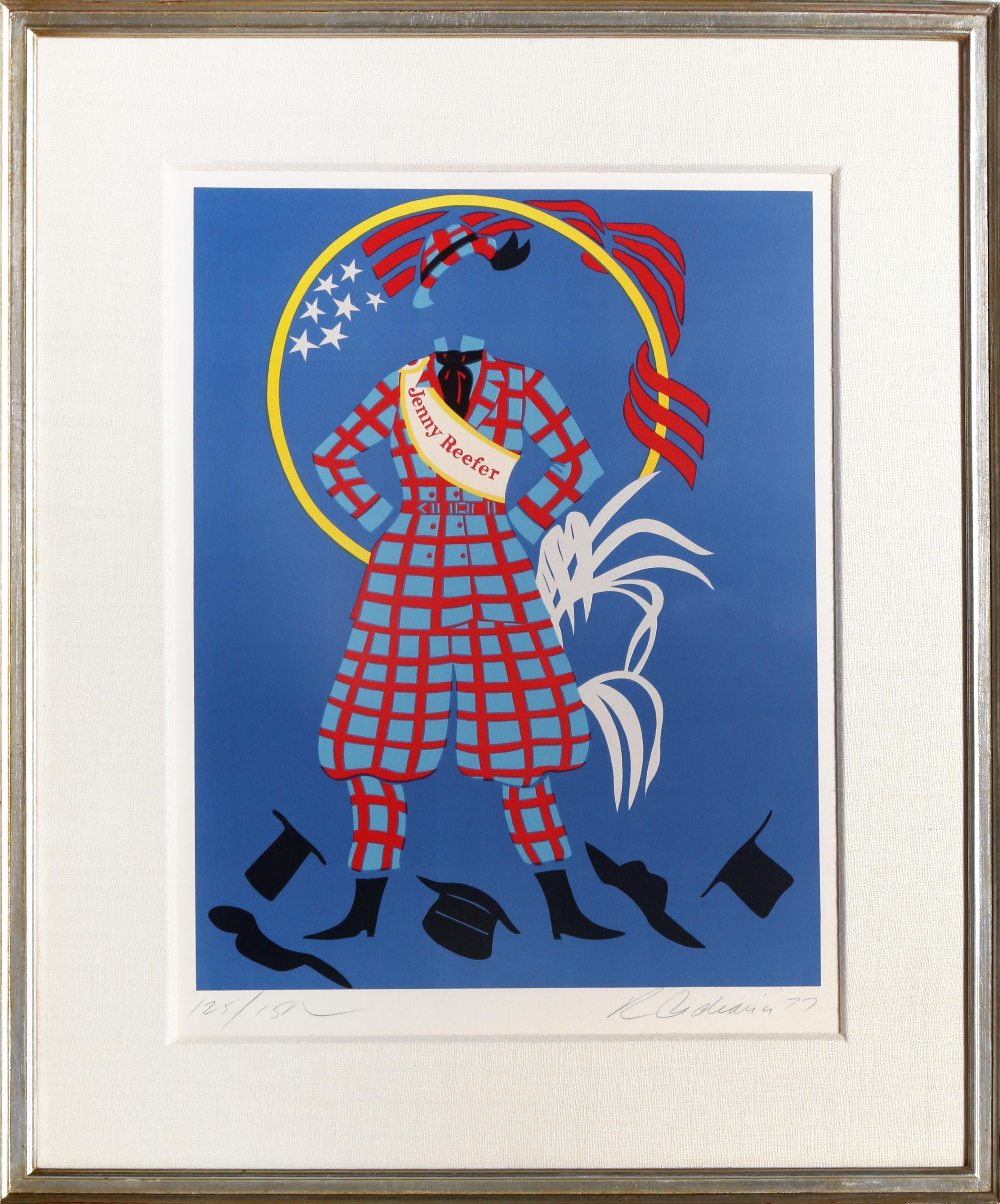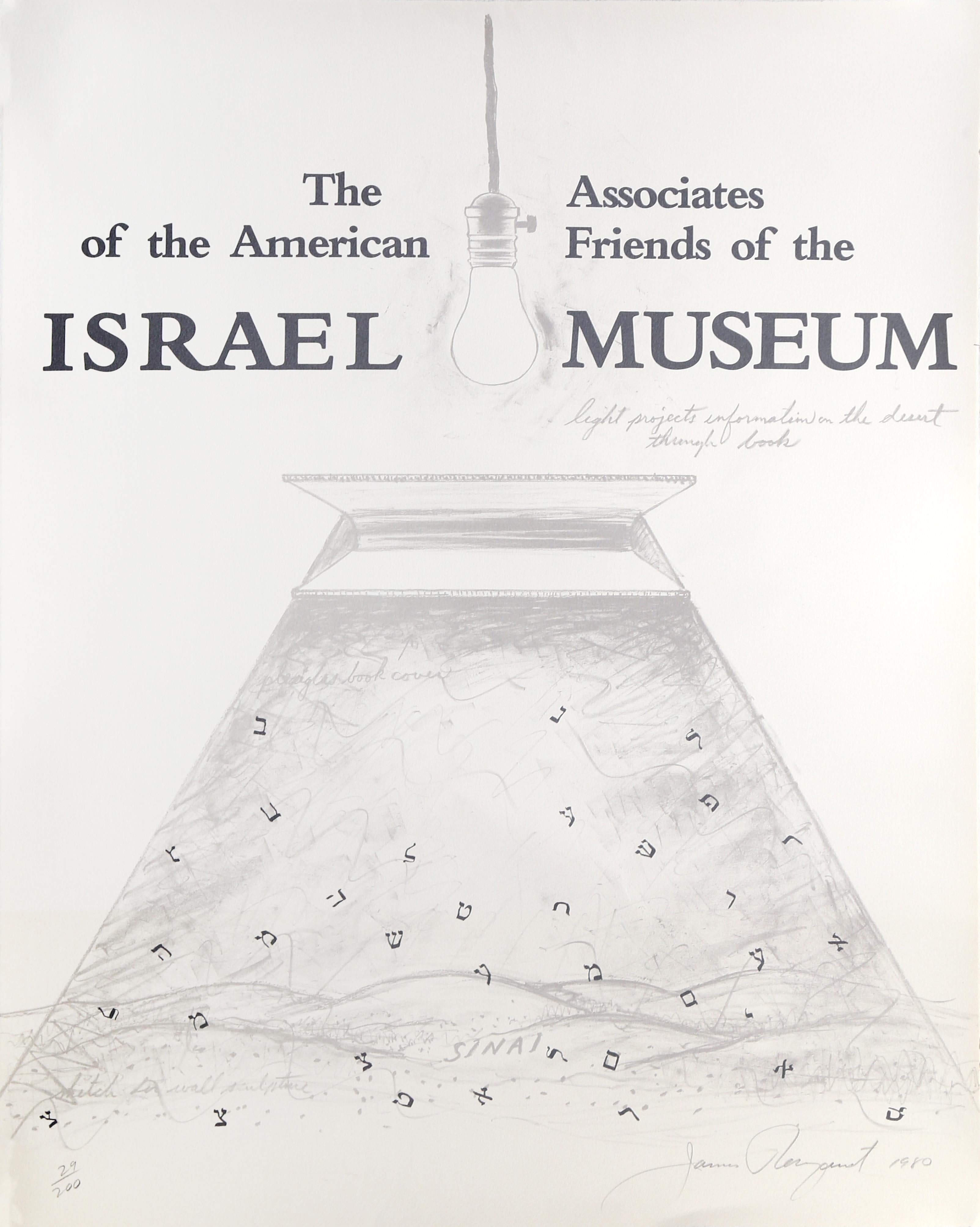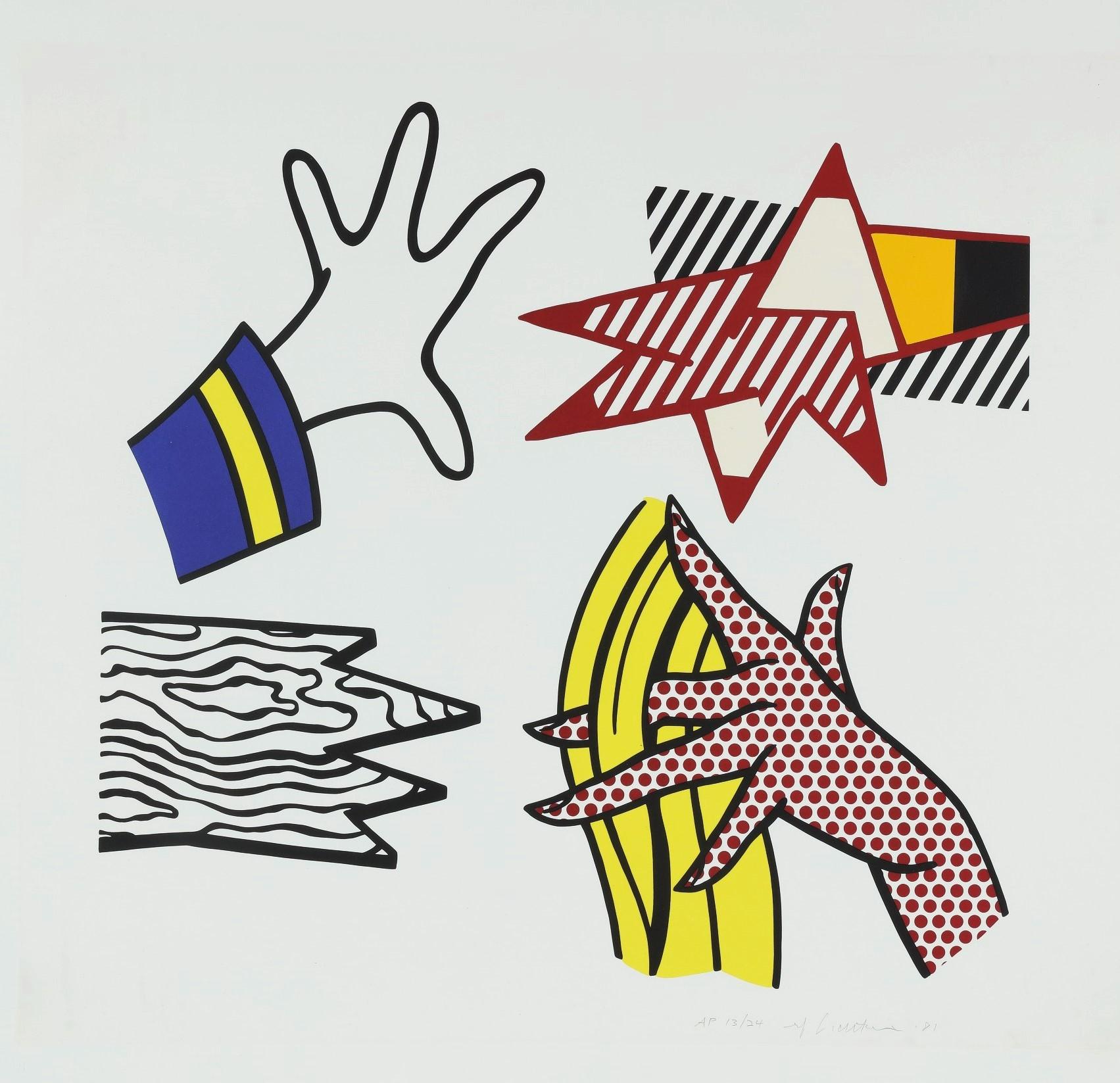James RosenquistMorning Mirror1966
1966
About the Item
- Creator:James Rosenquist (1933, American)
- Creation Year:1966
- Dimensions:Height: 24 in (60.96 cm)Width: 20 in (50.8 cm)
- Medium:
- Movement & Style:
- Period:
- Condition:
- Gallery Location:Palo Alto, CA
- Reference Number:
James Rosenquist
Although he insisted that he and his fellow Pop artists developed their art-making styles independently, American painter James Rosenquist belonged at the table with Andy Warhol and Roy Lichtenstein.
Known for his distinctive use of visual montage, Rosenquist produced large, vibrantly colored tableaux marked by fragmentation and overlap. He often employed familiar motifs and objects drawn from popular contemporary culture — hot dogs, lipstick tubes, American flags — which he manipulated to form disorienting compositions whose constituent elements are nearly unrecognizable.
Born in North Dakota to Swedish parents, Rosenquist was encouraged to pursue painting by his mother, who was also an artist. He studied painting for two years at the University of Minnesota, but dropped out at the age of 21 to attend the Art Students League in New York on a scholarship. A job as a billboard painter in the late 1950s set him up to pursue his signature style, which borrowed its bold graphics and remixed kitschy aesthetic from the visual vocabulary of advertising. Works like Flamingo Capsule (1983) embody his trademark visual dissonance, drawing cigarette-ad motifs into conversation with stripes from the American flag and aluminum foil wrappers.
In addition to enormous paintings, Rosenquist created drawings, prints and collages. The 2011 lithograph The Memory Continues but the Clock Disappears is a montage of melting clocks and confetti, all submerged in a pool of water. While wryly hinting at the inevitability of decay and deterioration — suggesting that life is a ticking clock — the composition also alludes to Salvador Dalí's signature motif, the defining symbol of Surrealism. Such compositions demonstrate how Rosenquist masterfully combined seemingly incongruous elements into a harmonious and poetic whole.
Find James Rosenquist art today on 1stDibs.
- ShippingRetrieving quote...Ships From: Palo Alto, CA
- Return PolicyA return for this item may be initiated within 7 days of delivery.
- Reflections on Minerva, from ReflectionsBy Roy LichtensteinLocated in Palo Alto, CAFramed in a bright yellow boarder, Roy Lichtenstein Reflections on Minerva, from Reflections, 1990 shows a distressed Minerva partially obscured by reflective lines. As if she is beh...Category
1990s Pop Art Figurative Prints
MaterialsLithograph, Screen
- Reflections on Brushstrokes, from the Reflections SeriesBy Roy LichtensteinLocated in Palo Alto, CARoy Lichtenstein Reflections on Brushstrokes, from the Reflections Series, 1990 incorporates his iconic multimedia imagery, flowing with eclectic and imaginative sequence of shapes. Bright colors of neon yellow, blue, gray, and green intertwine against each other creating a strong contrasting effect. Shapes and forms are irregularly placed within a rectangular frame allowing the composition to stand out. Lichtenstein’s famous dots are dispersed along the cream colored block running through mainly the center of the image. This creates a comic-like effect that is a common theme throughout his entire oeuvre. Because Reflections is an important series where Lichtenstein uses multimedia and relates to his Mirrors paintings of the early seventies. Dots, stripes, mirrors, prominent brushstrokes presents themselves in a dashing manner throughout this series. Created in 1990, Roy Lichtenstein Reflections on Brushstrokes, from the Reflections Series, 1990 is a color lithograph, screenprint, woodcut, and metalized PVC collage with embossing on Somerset paper. This work is hand signed and dated by Roy Lichtenstein (New York, 1923 – New York, 1997) in pencil in the lower right margin. Numbered from the edition of 68 in pencil in the lower right margin, there were also 16 artist proofs. Catalogue Raisonné: Roy Lichtenstein Reflections on Hair...Category
1990s Pop Art Figurative Prints
MaterialsLithograph, Screen, Woodcut
- Two Paintings: DagwoodBy Roy LichtensteinLocated in Palo Alto, CARoy Lichtenstein Two Paintings: Dagwood, 1984 is a vivid, colorful piece that demonstrates the clever work of Lichtenstein’s varied oeuvre. The work is c...Category
1980s Pop Art Figurative Prints
MaterialsWoodcut, Lithograph
- Nude, from Brushstroke Figures SeriesBy Roy LichtensteinLocated in Palo Alto, CARoy Lichtenstein Nude, from Brushstroke Figures Series, 1989 is a marvelous work that features Lichtenstein’s loose, freely Expressionistic brushstrokes combined with diagonal stripe...Category
1980s Pop Art Figurative Prints
MaterialsLithograph, Wax, Screen, Woodcut
- Nude Reading, from Nudes, 1994By Roy LichtensteinLocated in Palo Alto, CAIn Roy Lichtenstein Nude Reading, from Nudes, 1994, a woman comfortably lounges in her home, reading a book while devoid of clothes; derived in Lichtenstein’s classical style of high...Category
1990s Pop Art Figurative Prints
MaterialsScreen
- Plains Indian Shield, From the Cowboys and Indians SeriesBy Andy WarholLocated in Palo Alto, CACreated in 1986, this color screenprint on Lenox Museum Board is hand signed by Andy Warhol (Pennsylvania, 1928 - New York, 1987) in pencil in the lower left. A unique work inscribed ‘TP’ (trial proof) and numbered 7 from the edition of 36 unique trial proofs; aside from the edition of 250; published by Ronald Feldman Fine Arts, Inc., New York; printed by Rupert Jasen Smith, New York. Andy Warhol Cowboys and Indians Series: Andy Warhol’s Cowboys and Indians series of 1986 consists of ten prints each depicting their own respective subject—John Wayne, Annie Oakley, Kachina Dolls, Geronimo, Buffalo Nickel, Tonto, Theodore Roosevelt, General George Custer, Plains Indian Shield, and Northwest Coast Mask. Featuring images of famous American Western icons, Warhol’s series explores the relationship between Native Americans and Hollywood's portrayal of them in Western films. Warhol, being fascinated with celebrity culture, uses these famous figures to examine ways in which fame and popular culture intersect with history and myth. The Cowboys and Indians series was also created during a time at which Warhol was exploring his own Native American heritage. His mother was of Ruthenian and Carpatho-Rusyn descent, but Warhol claimed that his father was of Slovakian and Native American ancestry. Overall, the Cowboys and Indians series reflects Warhol's interest in American culture and history, as well as his fascination with celebrity and the intersection of art and commerce. This screenprint is part of a portfolio of works Warhol created in 1986 titled Cowboys and Indians. Other works in the Cowboys and Indians Series include General Custer, Sitting Bull, Kachina Dolls, Geronimo, Annie Oakley, War Bonnet Indian, Buffalo Nickel, Action Picture, Northwest Coast Mask, Plains Indians Shield, Mother and Child, Indian Head Nickel, and Teddy Roosevelt. Catalogue Raisonné: Andy Warhol Plains Indian Shield...Category
1980s Pop Art Figurative Prints
MaterialsScreen
- Spectacular : Surprised Girl - Original vintage lithograph poster, Maeght 1976By Jacques MonoryLocated in Paris, FRJacques Monory Spectacular : Surprised Girl, 1976 Original vintage lithograph poster Created for Monory's exhibition at Maeght Gallery On paper 60 x 45 cm (c. 24 x 18 in) Excelle...Category
1970s Pop Art Figurative Prints
MaterialsLithograph
- Careful : Wet Paint - Original lithograph, Handsigned - Limited /150By Valerio AdamiLocated in Paris, FRValerio ADAMI Careful : Wet Paint Original lithograph Handsigned in pencil Numbered /150 On vellum 67.5 x 50 cm (c. 27 x 20 inch) Excellent conditionCategory
1970s Pop Art Figurative Prints
MaterialsLithograph
- "Jenny Reefer" Lithograph by Robert IndianaBy Robert IndianaLocated in Long Island City, NYArtist: Robert Indiana, American (1928 - 2018) Title: Jenny Reefer from Mother of Us All Series Year: 1977 Medium: Lithograph on Arches, signed and numbered in pencil Edition: 125/1...Category
1970s Pop Art Figurative Prints
MaterialsLithograph
- Light Shines Through a Book on the SinaiBy James RosenquistLocated in Long Island City, NY"Light Shines Through a Book on the Sinai" is an original lithograph by James Rosenquist to benefit The Associates of the American Friends of Israel Museum in 1980. The print is sign...Category
1980s Pop Art Figurative Prints
MaterialsLithograph
- Study of HandsBy Roy LichtensteinLocated in New York, NYCreated in 1981 as an original lithograph with screen-printing, Roy Lichtenstein’s, Study of Hands is hand-signed in pencil, dated and numbered, measuring 31 ¼ x 32 ¾ in. (79.5 x 83....Category
20th Century Pop Art Figurative Prints
MaterialsLithograph, Screen
- 1971 Modernist Lithograph Redhead Pop Art Mod Fashionable Woman Richard LindnerBy Richard LindnerLocated in Surfside, FLRICHARD LINDNER (American. 1901-1978) Hand Signed limited edition lithograph with blindstamp Publisher: Shorewood-Bank Street Atelier for the Skowhegan School of Painting and Sculpture 29.25 X 22 inches Richard Lindner was born in Hamburg, Germany. In 1905 the family moved to Nuremberg, where Lindner's mother was owner of a custom-fitting corset business and Richard Lindner grew up and studied at the Kunstgewerbeschule (Arts and Crafts School since 1940 Academy of Fine Arts). From 1924 to 1927 he lived in Munich and studied there from 1925 at the Kunstakademie. In 1927 he moved to Berlin and stayed there until 1928, when he returned to Munich to become art director of a publishing firm. He remained there until 1933, when he was forced to flee to Paris, where he became politically engaged, sought contact with French artists and earned his living as a commercial artist. He was interned when the war broke out in 1939 and later served in the French Army. In 1941 he went to the United States and worked in New York City as an illustrator of books and magazines (Vogue, Fortune and Harper's Bazaar). He began painting seriously in 1952, holding his first one-man exhibit in 1954. His style blends a mechanistic cubism with personal images and haunting symbolism. LIndner maintained contact with the emigre community including New York artists and German emigrants (Albert Einstein, Marlene Dietrich, Saul Steinberg). Though he became a United States citizen in 1948, Lindner considered himself a New Yorker, but not a true American. However, over the course of time, his continental circus women became New York City streetwalkers. New York police uniforms replaced European military uniforms as symbols of authority.At a time when Abstract Expressionism was all the rage, Lindner’s painting went against the current and always kept its distance. His pictorial language of vibrant colours and broad planes of colour and his urban themes make him a forerunner of American Pop Art. At the same time, he owes the critical tone of his paintings to the influence of European art movements such as Neue Sachlichkeit and Dada. His first exhibition did not take place until 1954, by which time he was over fifty, and, interestingly, it was held at the Betty Parsons Gallery in New York, a venue associated with the American Expressionists. From 1952 he taught at the Pratt Institute, Brooklyn, from 1967 at Yale University School of Art and Architecture, New Haven. In 1957 Lindner got the William and Norma Copley Foundation-Award. In 1965 he became Guest Professor at the Akademie für Bildende Künste, Hamburg. His Ice (1966, Whitney Museum of American Art) established a connection between the metaphysical tradition and pop art. He did work on Rowlux which was used by a number of pop artists (most notably Roy Lichtenstein)The painting shows harsh, flat geometric shapes framing an erotic but mechanical robot-woman. His paintings used the sexual symbolism of advertising and investigated definitions of gender roles in the media. While influencing Pop Art (Andy Warhol, Tom Wesselmann and Claes Oldenburg amongst others) his highly colourful, hard-edge style seems to have brought him close to Pop Art, which he rejected. Nevertheless, he is immortalised on the cover of the Beatles record "Sgt. Pepper’s Lonely Hearts Club Band" (1967) as a patron of the pop culture. He also did a tapestry banner with the Betsy Ross Flag...Category
1970s Pop Art Abstract Prints
MaterialsLithograph



